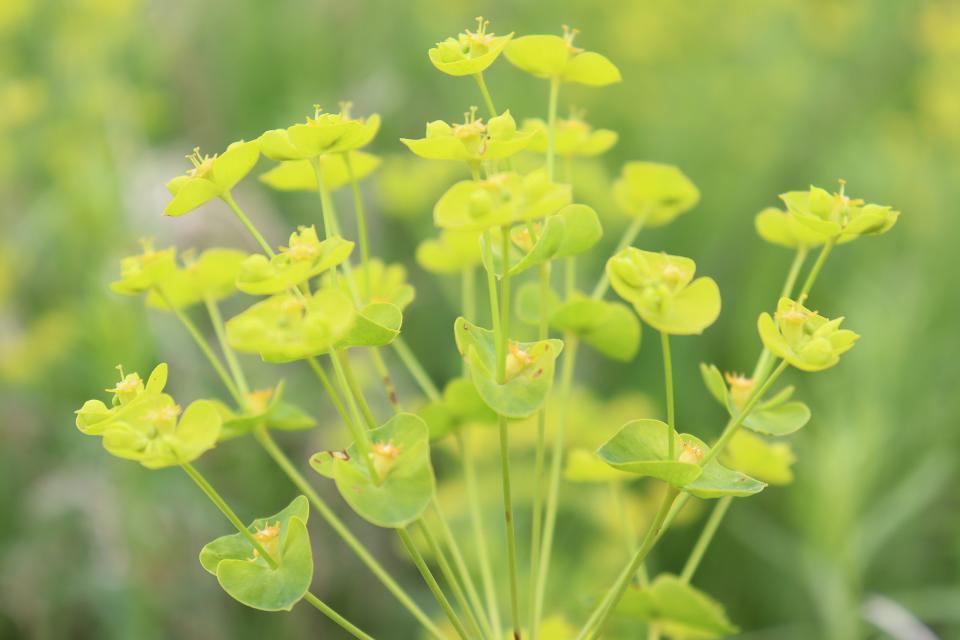
Pasture and Forage Minute: Controlling Alfalfa Weevil and Leafy Spurge, First Cutting Alfalfa
Late Spring Alfalfa Weevil Update
As we approach the first cutting for alfalfa across the state of Nebraska, it is important to continue to monitor your fields for alfalfa weevil.
Plant injury from alfalfa weevil feeding damage appears as pinholes in the terminal leaves, with leaves becoming skeletonized as feeding severity increases. Adult beetles are roughly 5 mm in length with a blunt snout and a brown body with a darker brown stripe running down the center of the back. Larvae are 1.5 mm to 8.5 mm long with a black head, wrinkled green body and white stripe running lengthwise along the top. They will curl into a C-shape when disturbed.
Scouting for alfalfa weevil up to and even during the first cutting can help to mitigate economic losses. First, use a sweep net to determine whether larvae are present. If larvae are present, randomly select five sites across the field and collect 10 stems at each site, cutting the stems at ground level. Beat the stems into a deep-sided bucket, count the number of larvae to determine the average number per stem. While you are actively cutting your alfalfa field, take some time to inspect your equipment for larvae. Economic thresholds for alfalfa weevil can vary greatly from an average of one to seven larvae per stem, depending on a variety of factors. Threshold tables can be found on the CropWatch website.
A variety of insecticides are labeled for alfalfa weevil control, including pyrethroids and products containing indoxacarb (such as Steward). Pyrethroids are more harmful to natural enemies of alfalfa weevil, while indoxacarb is more selective and may help to maintain beneficial insect populations. When alfalfa reaches 50% or more bud stage, it may be more profitable to cut the alfalfa early rather than treat it.
Leafy Spurge Control
Yellow-green patches in a pasture might look pretty for the uninitiated, but the telltale bloom of leafy spurge is not a spring sight many of us want to see.
While there are many plants livestock producers may consider pasture weeds, one that is particularly disliked is leafy spurge. Besides being on the Nebraska noxious weed list and requiring control, this hardy perennial spreads aggressively through seeds and root buds. With an extensive root system that can reach depths up to 15 feet, once established spurge is hard to control.
While biological and cultural control methods may provide some reduction in growth and seed production, those wanting complete control might consider an herbicide treatment as the best option.
Multiple chemicals have action on spurge; however, for spring treatments, control at bud or true flower stage is recommended. Options for application at the bud stage are 2,4-D ester (4L), Graslan L®, Tordon 22K® or Picloram 22K. If applying a bit later at flower stage, options include Curtail®/Cody®/Stinger®, Streamline®, an Overdrive® + Tordon 22K® mix, or a Sharpen® + Plateau® mix.
Unfortunately, a single treatment will not control spurge, so continued monitoring and retreatment is necessary. An effective strategy is pairing spring applications that prevent seed production with a fall treatment to control new growth.
Leafy spurge can easily take over a pasture, but with vigilance and regular treatment, control can be achieved.
First Cutting Alfalfa
Since our 2023 accumulated growing degree days have pegged 650 GDDs, now is the time to harvest your first cutting alfalfa. Moving forward, if the first cutting is delayed after one-tenth bloom or later, then potential alfalfa regrowth will be removed with the first cutting, thus delaying the next hay crop. This cutting timing strategy provides a compromise between maximizing forage production versus retaining nutritional quality, which declines as alfalfa stems mature.
In fields where irrigation has not been an option, lack of soil moisture will likely result in disappointing first cutting forage yields. In addition to drought, insect damage may have caused premature leaf loss, thus requiring early cutting before alfalfa crown regrowth or one-tenth bloom to salvage what remains.
For other parts of the state, recent rainfall and warm weather may have stimulated rapid alfalfa growth — this means those needing dairy quality forage may need to cut hay soon. First cutting alfalfa hay quality declines quicker compared to the second, third or fourth cuttings.
For those wanting to maximize quantity and replenish hay reserves, delaying harvest just a little longer until almost full bloom will likely result in higher yields. Alfalfa will be more efficient using available soil moisture if cutting is delayed until bloom but likely reduce total season cuttings. If your operation needs more roughage tonnage, delaying cutting for higher yield and lower quality is better. However, if higher protein content is needed, then earlier cutting will produce a higher quality hay. Remember, though, that continually cutting alfalfa at the early pre-bud stage will weaken plants and potentially increase weedy conditions.
Online Master of Science in Agronomy
With a focus on industry applications and research, the online program is designed with maximum flexibility for today's working professionals.
